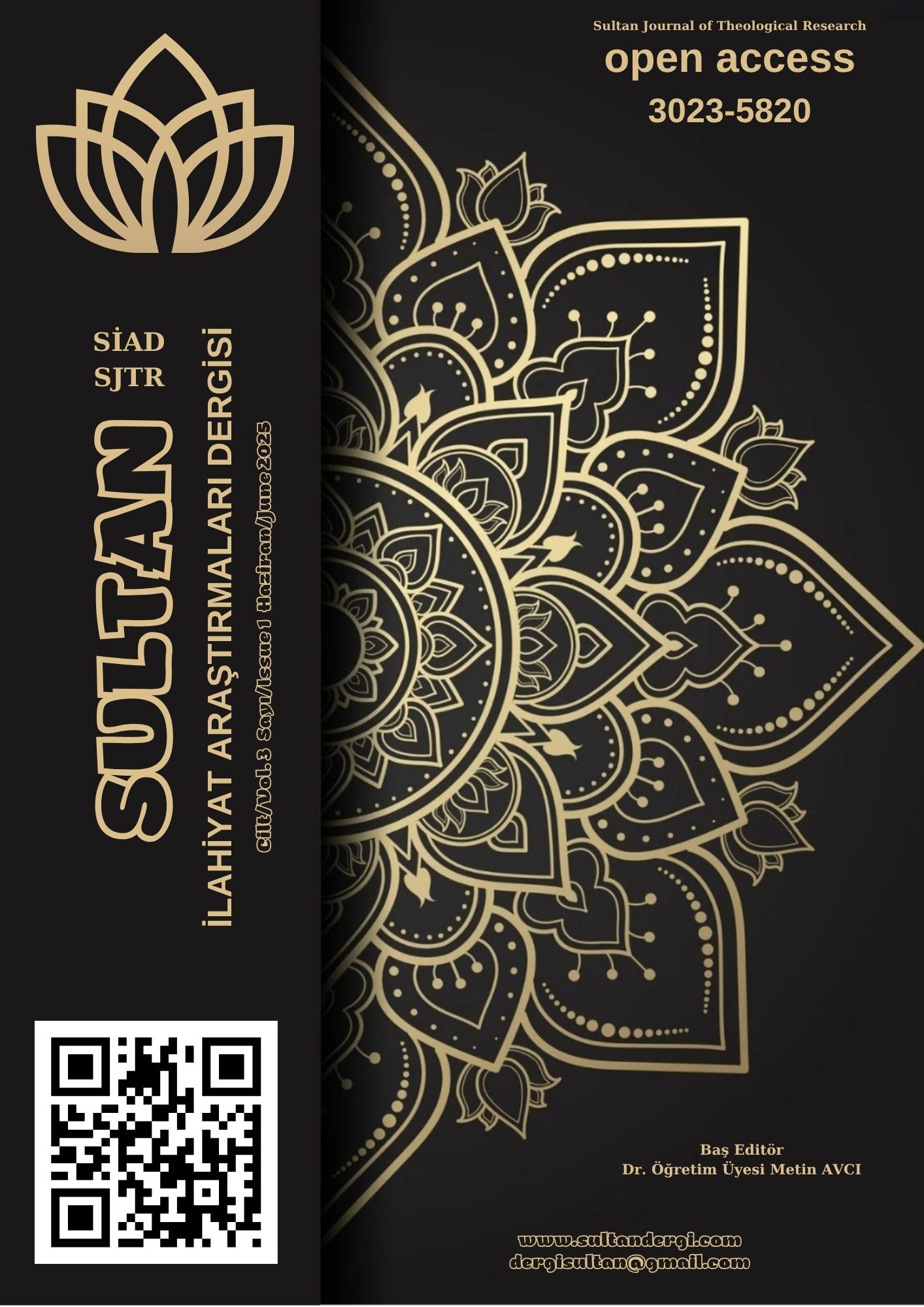An Art of Religious Exploitation: Storytelling
DOI:
https://doi.org/10.5281/zenodo.15776961Keywords:
Kalam, Religion, Exploitation, The Art of Deceit, Narrative.Abstract
Religious abuse is the desire to control emotions and distract human reason from what is reasonable. The intense exposure of a religion to emotionality is the distortion of the sphere of values. Therefore, religious abuse is the desire to render the principles and values of a religion dysfunctional for the sake of worldly interests. In its negative sense, parable telling is the intentional creation of confusion and dissemination of false information in order to gain some benefit. One of the main reasons for the lack of reasoning is that parable-tellers, for the sake of worldly interests, influence the masses through enthusiastic sermons, high-tone speeches, intense emotionality, and deceptive assurance. The inability to counter unfounded rumors, exaggerated stories and fictional discourses with reasonable measures is the transformation of religion into myth. In this way, false information can be made more widespread and vibrant than true information. When a religion begins to inculcate itself into society through fictions, it is inevitable that values degenerate and the principles and values of religion become dysfunctional. This means that the expectations of a storyteller and the real ideals of religion do not coincide. Since it is not possible for true religion to market and commercialize itself, a religious understanding that becomes identical with the desire for rent and profit is tantamount to nothing. What the article wants to emphasize is the destructive effect of a belief that religion exists to serve itself. In this respect, the article will examine the role of storytellers in the abuse of religion in a descriptive way. Since the article deals with the problematic dimension of the issue, it will not include the historical process or detailed conceptual analysis. Since the article leaves the comparison between the past and the present to the reader's perception, the mental analysis will be reflected in the text.
Highlights
- Religious abuse is the desire to control emotions and distract human reason from what is reasonable.
- Parable-telling is the deliberate creation of confusion and dissemination of false information in order to gain some benefit.
- If the ignorance-based self-confidence of the storytellers is appreciated and respected in a society, the ability to doubt, criticize and object will cease in that society, and thus knowledge and wisdom and all kinds of development will cease.
- Since it is not possible for true religion to market and commercialize itself, a religious understanding that becomes identical with the desire for rent and profit is tantamount to nothing.
- When the interests of the storytellers and the ideals of religion are equated, emotions are uncontrollable and all kinds of extremism and aggression can find a rationalized ground.
References
Ateş, Ali Osman. “Din Tahrîfi ve İstismarı”. Çukurova Üniversitesi İlahiyat Fakültesi Dergisi 4/1 (Ocak-Haziran 2004), 1-39.
Berkey, Jonathan P. “Storytelling, Preaching, and Power in Mamluk Cairo”, Mamluk Studies Review 4 (2000), 53-73.
Bilgin, Vecdi. “İstismar ve Din İstismarı Üzerine Genel Bir Çerçeve”. Siyer Araştırmaları Dergisi 4 (2018), 161-169.
Câbirî, Muhammed Âbid. İslam Düşüncesinde Demokrasi İnsan Hakları ve Hukuk. çev. Mehmet Şayir. İstanbul: Kapı Yayınları, 2019.
Câhiz, Ebû Osmân Amr b. Bahr b. Mahbûb. el-Beyân ve’t-Tebyîn. thk. Abdüsselam Muhammed Harun. Kahire: Mektebetü Hânci, 1997.
Certel, Hüseyin. “Din İstismarı Üzerine”. İslâmi Araştırmalar 22/1 (2011), 1-11.
Cübbâî, Ebû Ali. Kitâbü’l-Makâlât-İtikâdî Mezheplere Yönelik Klasik Bir Eleştiri, thk. ve çev. Özkan Şimşek-A. İskender Arıca-Yusuf Arıkaner. İstanbul: Endülüs Yayınları, 2019.
Çinemre, Semra. “Yaygın Din Eğitiminin Toplumu Din İstismarı Konusunda Aydınlatmaya Katkısı: Cuma Hutbeleri Üzerinden Bir İnceleme”. ilted: ilahiyat tetkikleri dergisi / journal of ilahiyat researches 56 (Aralık 2021/2), 329-358.
Dırâr b. Amr. Kitabü’t-Tahriş. thk. Hüseyin Hansu-Mehmet Keskin. İstanbul: Şirketü Dârü’l-İrşâd, 2014.
Endelüsî, Ebû Hayyân. Tefsîru’l-bahri’l-Muhît. thk. Âdil Ahmed Abdilmevcûd-Ali Muhammed Muavvıd. Beyrut: Dâru’l-Kütübi’l-İlmiyye, 1993.
Hafızoğlu, Yakup. “İmam Mâtürîdî’ye Göre Nübüvvet ve İspatında Erdemin Önemi”. Amasya İlahiyat Dergisi 20 (Haziran 2023 ): 143-170.
Hoffer, Eric. The True Believer (Kesin İnançlılar). çev. Erkıl Günur. İstanbul: Plato Film Yayınları, 2007.
Irâkî, Ebü’l-Fazl Zeynüddîn Abdürrahîm b. el-Hüseyn b. Abdirrahmân. el-Bâʿis ʿale’l-Halâs min Havâdisi’l-Kussâs, thk. Muhammed Lütfi es-Sabbâğ. Beyrut: Dârü’l-Verrâk, 2001.
İbn Kuteybe, Ebû Muhammed Abdullah b. Müslim. Te’vîlü Muhtelifi’l-Hadîs, thk. Muhammed Muhyiddîn el-Esfar. Beyrut: Mektebetü’l-İslamî, 1999.
İbn Manzûr. Lisânü'l-ʿArab. thk. Abdullah Ali el-Kebir vd. Kahire: Dârü’l-Meârif, ts.
İbnü’l-Cevzî, Ebü’l-Ferec. Kitâbü’l-Kussâs ve’l-Müzekkirîn. thk. Muhammed b. Lütfî es-Sabbâğ. Beyrut: Mektebetü’l-İslamiyyi, 1983.
İbnü’l-Cevzî, Ebü’l-Ferec. Telbisü’l-İblis. İskenderiye: Dârü İbn Haldun, ts.
İbnü’l-Cevzî. Kitâbü’l-Mevzuat min-Ehâdisi’l-Merfuât. thk. Nureddin b. Şükrî b. Ali Boyacılar. Beyrut: Mektebetü Edvâü’s-Selef, 1997.
Kindî, Ebû Yûsuf Ya‘kûb b. İshâk b. es-Sabbâh. Resâilu’l-Kindi’l-Felsefiyye. thk. Muhammed Abdulhâdî Ebû Rîde. Kahire: Dâru’l-Fikri’l-Arabî, 1950.
Le Bon, Gustave, Kitleler Psikolojisi, çev. Yunus Ender. İstanbul: Hayat Yayıncılık, 2009.
Lynch, Kevin. “Self-Deception and Stubborn Belief”. Pre-print of paper published in Erkenntnis 17/1 (2014), 63-75.
Makdisî, Mutahhar b. Tâhir. Kitabü’l-Bed’i ve’t-Tarih. Kahire: Mektebetü’s-Sekafiyyi ve’d-Dinî, ts.
Malik, Zaib. “Story Telling Technique of The Noble Quran And Its Effect on The Human Mind”. Jaheen e-Tahqeeq 4/3 (2021), 774-785.
Maraz, Hüseyin. “Fanatizm Olgusu ve Dinî Kült Yapılarda Eleştirisizliğin Eleştirisi”. Kader 16/2 (Aralık 2018), 404-432. https://doi.org/10.18317/kaderdergi.464870
Metz, Adam. el-Hadâratü’l-İslâmiyye fi’l-Karnir-Rabî’il-Hicrî. çev. Muhammed Abdülhâdi Ebû Rîde. Beyrut: Dârü’l-Kütübi’l-İlmiyye, ts.
Nablusî, Muhammed Râtib. Tefsiru’l-Kur’ani’l-Kerim-Su’retü’l-A’raf. Erişim 28 Nisan 2025. https://archive.org/details/01187-pdf
Northbourne, Lord. Religion in the Modern World (Modern Dünyada Din). çev. Şehabeddin Yalçın. İstanbul: İnsan Yayınları, 2003.
Okumuş, Ejder. “Bir Din İstismarı Olarak Gösterişçi Dindarlık”. İslâmiyât 5/4 (2002), 193-205.
Sabbâğ Muhammed b. Lütfî. Târihü’l-Kussâs ve Eserühüm fî’l-Hadîsi’n-Nebevî ve Ra’yü’l-Ulemâi fîhim. Beyrut: el-Mektebetü'l-İslâmî, h. 1404.
Seyyid, Ahmed b. Yusuf, Mukâvemetü’t-Tefâha. İstanbul: Manârü’l-Fikr, 2023.
Sıbağî, Mustafa. es-Sünnetü ve Mekânetühâ fi’-t-Teşrî’-İslamî. Beyrut: Dârü’l-Verrâk, ts.
Suyûtî, Celâluddîn. Tahzîru’l-Havâs min-Ekâzîbi’l-Kussâs. thk. Muhammed b. Lütfî es-Sabbâğ. Beyrut: Mektebetü’l-İslâmiyyi, 1984.
Taşköprülüzade, Ahmed Efendi. Miftâhu’s-Seâde ve Misbâhu’s-Siyâde. Beyrut: Dâru’l-Kütübi’l-İlmiyye, 1985.
Verdî, Ali. Vü’âzü’s-Selâtîn. London: Dâru Kufaan, 1995.
Yaz, Dursun Ali. Raranın Yazılmamış Tarihi-Antik Çağdan Geleceğe Para. İstanbul: Timaş Yayınları, 2024.
Zehebî, Şemsüddîn Muhammed. Siyeru Aʿlâmi’n-Nübelâ. Beyrut: Müessesetü'r-Risâle, 1982.
Downloads
Published
How to Cite
Issue
Section
License
Copyright (c) 2025 Hüseyin Maraz

This work is licensed under a Creative Commons Attribution-NonCommercial 4.0 International License.





